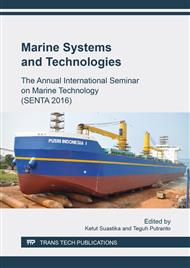p.140
p.147
p.155
p.165
p.174
p.181
p.189
p.199
p.207
Production Capacity Analysis of National Shipyard in Indonesia to Build Sea Toll Ships
Abstract:
Indonesian government, in period 2014-2019, has launched Toll Sea program. A number of 188 various sizes and types of ships types will be built for this program. Ship building process must be supported by a national shipbuilding capability and capacity. Unfortunately, there are any vagueness of information on the number of shipyards and their production capacity. The records of data and shipyard production capabilities and also capacity haven’t been documented well. Moreover, there are many new and emerging shipyards although some become bankruptcy. Analyzing the production capacity of national shipyards to build Sea Toll vessels has become the aims of this research. The first step is grouping ships based on GT size. Afterwards, the weight of the steel is estimated using Watson equations. Determination of shipyard criteria is created regarding the size of building birth facility, main workshop productions, experience to build sea toll ship, the number of man-powers, and the existence of ISO and OHSAS certificate. In accordance with the steel through put of the shipyards, it can be conclude that 64 sea toll ships can be built in a year with estimation about 26,767,29 ton/year.
Info:
Periodical:
Pages:
174-180
Citation:
Online since:
January 2018
Authors:
Keywords:
Price:
Сopyright:
© 2018 Trans Tech Publications Ltd. All Rights Reserved
Share:
Citation:


